The Importance of Varied Leadership Styles in Modern Nursing Practice
VerifiedAdded on 2023/06/12
|9
|2193
|234
Essay
AI Summary
This essay explores the importance of various leadership styles in nursing, arguing that no single style is universally effective. It begins by discussing transformational leadership, highlighting its strengths in change management but its limitations in crisis situations. The essay then introduces situational leadership as a flexible approach for handling crises, exemplified by a natural disaster scenario. Democratic leadership is presented as a style that values employee input and is beneficial for addressing burnout and conflicts. The essay concludes by advocating for aesthetic leadership, which emphasizes ethics and morality, enabling leaders to adapt their style based on the situation. It suggests that future nursing leaders should be versatile, modifying their approaches to meet the diverse needs of healthcare environments and effectively lead their teams.
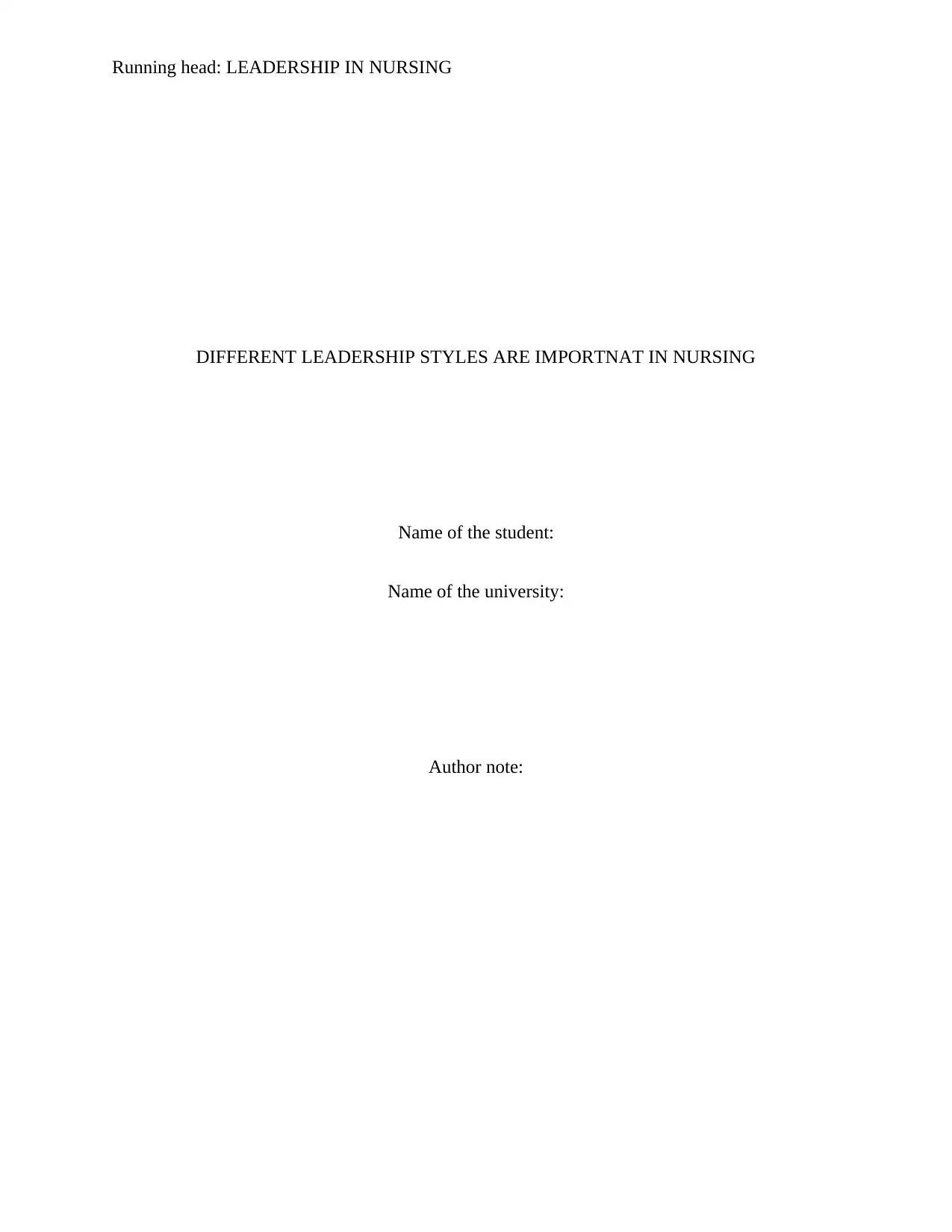
Running head: LEADERSHIP IN NURSING
DIFFERENT LEADERSHIP STYLES ARE IMPORTNAT IN NURSING
Name of the student:
Name of the university:
Author note:
DIFFERENT LEADERSHIP STYLES ARE IMPORTNAT IN NURSING
Name of the student:
Name of the university:
Author note:
Secure Best Marks with AI Grader
Need help grading? Try our AI Grader for instant feedback on your assignments.
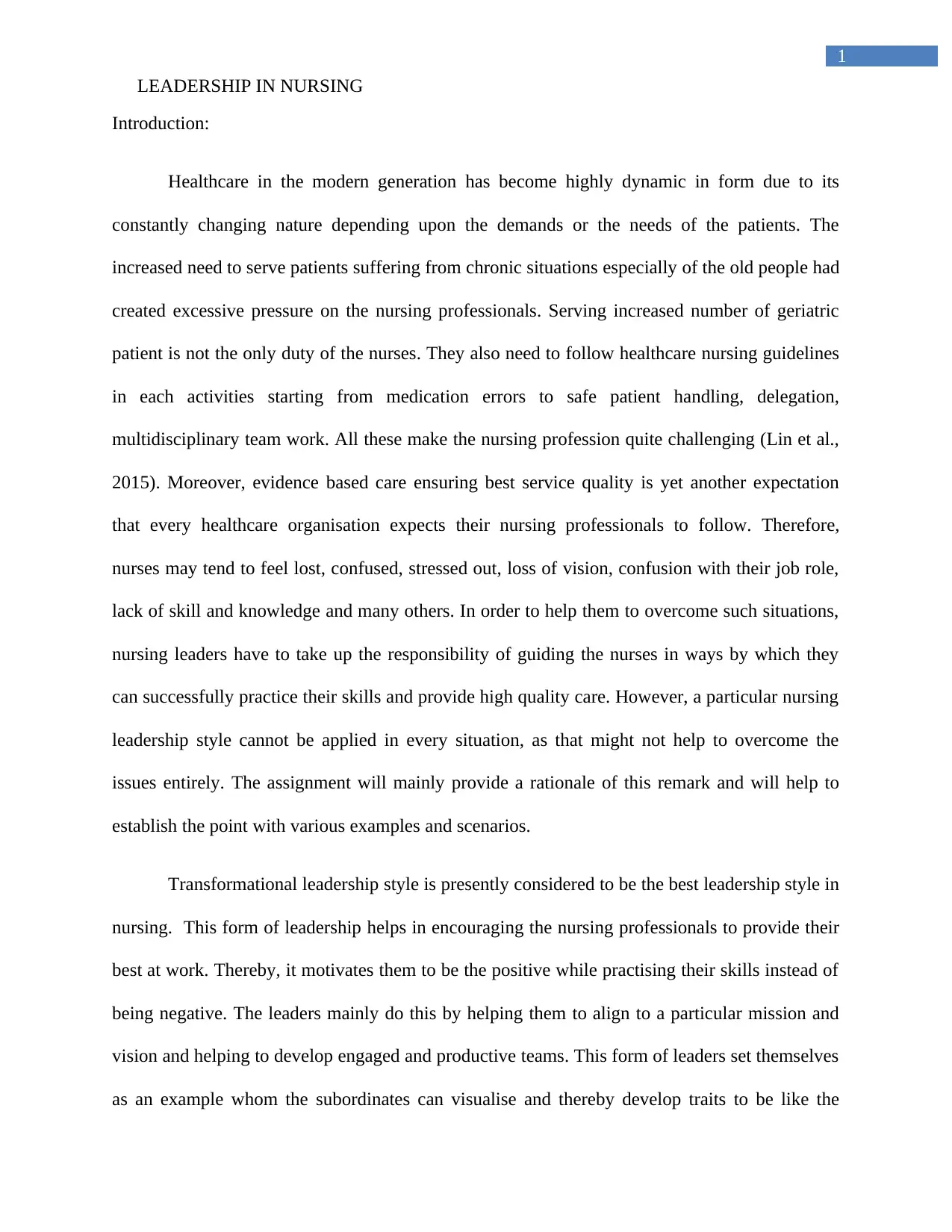
1
LEADERSHIP IN NURSING
Introduction:
Healthcare in the modern generation has become highly dynamic in form due to its
constantly changing nature depending upon the demands or the needs of the patients. The
increased need to serve patients suffering from chronic situations especially of the old people had
created excessive pressure on the nursing professionals. Serving increased number of geriatric
patient is not the only duty of the nurses. They also need to follow healthcare nursing guidelines
in each activities starting from medication errors to safe patient handling, delegation,
multidisciplinary team work. All these make the nursing profession quite challenging (Lin et al.,
2015). Moreover, evidence based care ensuring best service quality is yet another expectation
that every healthcare organisation expects their nursing professionals to follow. Therefore,
nurses may tend to feel lost, confused, stressed out, loss of vision, confusion with their job role,
lack of skill and knowledge and many others. In order to help them to overcome such situations,
nursing leaders have to take up the responsibility of guiding the nurses in ways by which they
can successfully practice their skills and provide high quality care. However, a particular nursing
leadership style cannot be applied in every situation, as that might not help to overcome the
issues entirely. The assignment will mainly provide a rationale of this remark and will help to
establish the point with various examples and scenarios.
Transformational leadership style is presently considered to be the best leadership style in
nursing. This form of leadership helps in encouraging the nursing professionals to provide their
best at work. Thereby, it motivates them to be the positive while practising their skills instead of
being negative. The leaders mainly do this by helping them to align to a particular mission and
vision and helping to develop engaged and productive teams. This form of leaders set themselves
as an example whom the subordinates can visualise and thereby develop traits to be like the
LEADERSHIP IN NURSING
Introduction:
Healthcare in the modern generation has become highly dynamic in form due to its
constantly changing nature depending upon the demands or the needs of the patients. The
increased need to serve patients suffering from chronic situations especially of the old people had
created excessive pressure on the nursing professionals. Serving increased number of geriatric
patient is not the only duty of the nurses. They also need to follow healthcare nursing guidelines
in each activities starting from medication errors to safe patient handling, delegation,
multidisciplinary team work. All these make the nursing profession quite challenging (Lin et al.,
2015). Moreover, evidence based care ensuring best service quality is yet another expectation
that every healthcare organisation expects their nursing professionals to follow. Therefore,
nurses may tend to feel lost, confused, stressed out, loss of vision, confusion with their job role,
lack of skill and knowledge and many others. In order to help them to overcome such situations,
nursing leaders have to take up the responsibility of guiding the nurses in ways by which they
can successfully practice their skills and provide high quality care. However, a particular nursing
leadership style cannot be applied in every situation, as that might not help to overcome the
issues entirely. The assignment will mainly provide a rationale of this remark and will help to
establish the point with various examples and scenarios.
Transformational leadership style is presently considered to be the best leadership style in
nursing. This form of leadership helps in encouraging the nursing professionals to provide their
best at work. Thereby, it motivates them to be the positive while practising their skills instead of
being negative. The leaders mainly do this by helping them to align to a particular mission and
vision and helping to develop engaged and productive teams. This form of leaders set themselves
as an example whom the subordinates can visualise and thereby develop traits to be like the
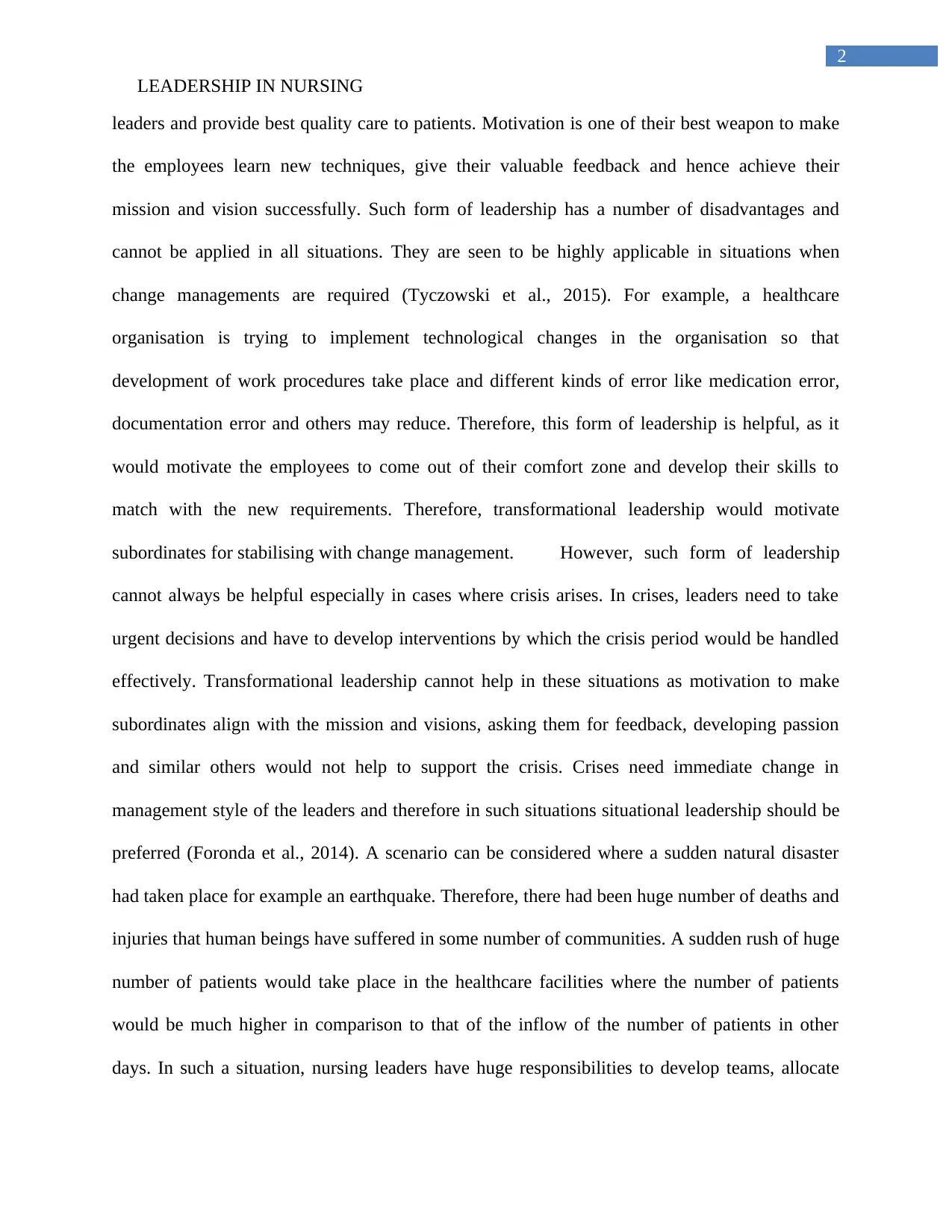
2
LEADERSHIP IN NURSING
leaders and provide best quality care to patients. Motivation is one of their best weapon to make
the employees learn new techniques, give their valuable feedback and hence achieve their
mission and vision successfully. Such form of leadership has a number of disadvantages and
cannot be applied in all situations. They are seen to be highly applicable in situations when
change managements are required (Tyczowski et al., 2015). For example, a healthcare
organisation is trying to implement technological changes in the organisation so that
development of work procedures take place and different kinds of error like medication error,
documentation error and others may reduce. Therefore, this form of leadership is helpful, as it
would motivate the employees to come out of their comfort zone and develop their skills to
match with the new requirements. Therefore, transformational leadership would motivate
subordinates for stabilising with change management. However, such form of leadership
cannot always be helpful especially in cases where crisis arises. In crises, leaders need to take
urgent decisions and have to develop interventions by which the crisis period would be handled
effectively. Transformational leadership cannot help in these situations as motivation to make
subordinates align with the mission and visions, asking them for feedback, developing passion
and similar others would not help to support the crisis. Crises need immediate change in
management style of the leaders and therefore in such situations situational leadership should be
preferred (Foronda et al., 2014). A scenario can be considered where a sudden natural disaster
had taken place for example an earthquake. Therefore, there had been huge number of deaths and
injuries that human beings have suffered in some number of communities. A sudden rush of huge
number of patients would take place in the healthcare facilities where the number of patients
would be much higher in comparison to that of the inflow of the number of patients in other
days. In such a situation, nursing leaders have huge responsibilities to develop teams, allocate
LEADERSHIP IN NURSING
leaders and provide best quality care to patients. Motivation is one of their best weapon to make
the employees learn new techniques, give their valuable feedback and hence achieve their
mission and vision successfully. Such form of leadership has a number of disadvantages and
cannot be applied in all situations. They are seen to be highly applicable in situations when
change managements are required (Tyczowski et al., 2015). For example, a healthcare
organisation is trying to implement technological changes in the organisation so that
development of work procedures take place and different kinds of error like medication error,
documentation error and others may reduce. Therefore, this form of leadership is helpful, as it
would motivate the employees to come out of their comfort zone and develop their skills to
match with the new requirements. Therefore, transformational leadership would motivate
subordinates for stabilising with change management. However, such form of leadership
cannot always be helpful especially in cases where crisis arises. In crises, leaders need to take
urgent decisions and have to develop interventions by which the crisis period would be handled
effectively. Transformational leadership cannot help in these situations as motivation to make
subordinates align with the mission and visions, asking them for feedback, developing passion
and similar others would not help to support the crisis. Crises need immediate change in
management style of the leaders and therefore in such situations situational leadership should be
preferred (Foronda et al., 2014). A scenario can be considered where a sudden natural disaster
had taken place for example an earthquake. Therefore, there had been huge number of deaths and
injuries that human beings have suffered in some number of communities. A sudden rush of huge
number of patients would take place in the healthcare facilities where the number of patients
would be much higher in comparison to that of the inflow of the number of patients in other
days. In such a situation, nursing leaders have huge responsibilities to develop teams, allocate
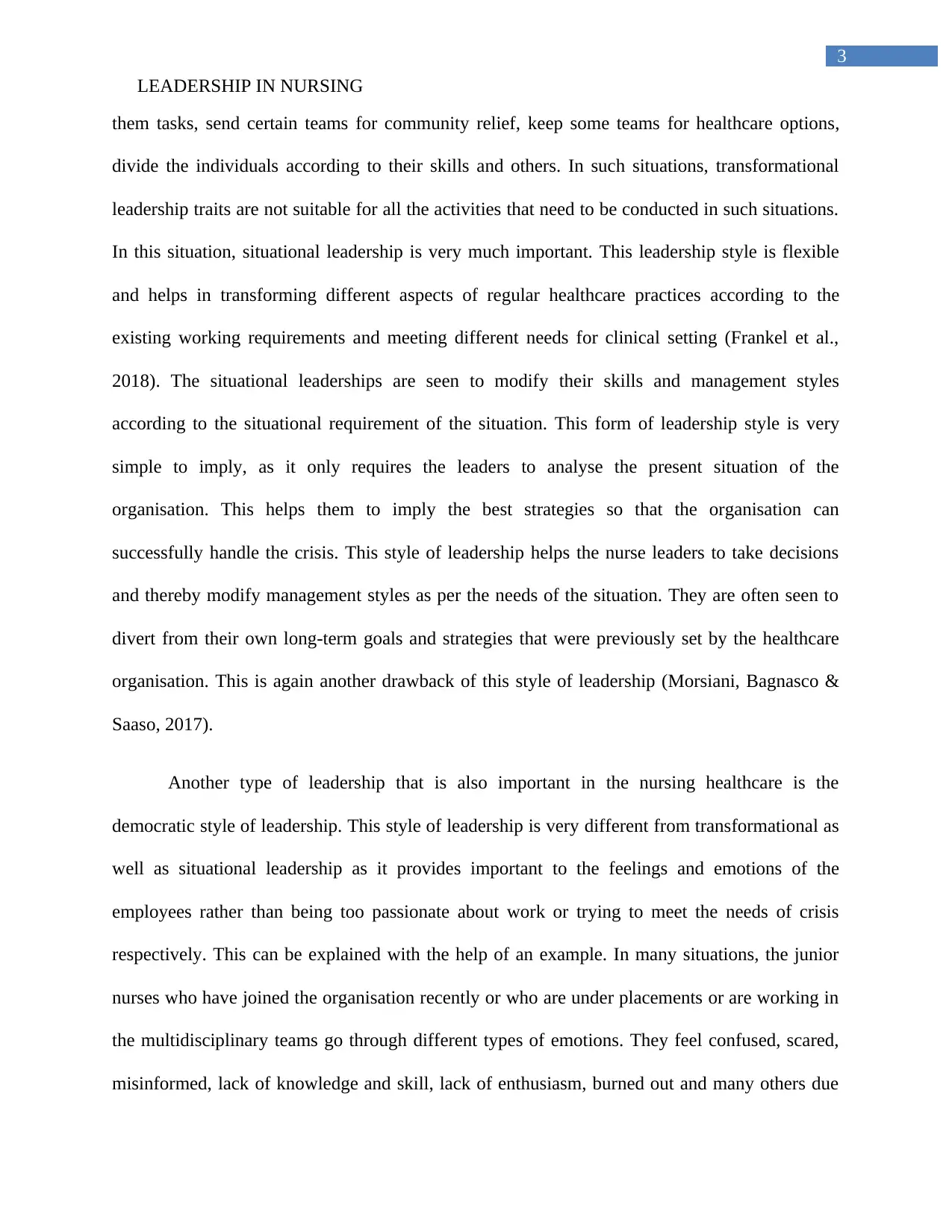
3
LEADERSHIP IN NURSING
them tasks, send certain teams for community relief, keep some teams for healthcare options,
divide the individuals according to their skills and others. In such situations, transformational
leadership traits are not suitable for all the activities that need to be conducted in such situations.
In this situation, situational leadership is very much important. This leadership style is flexible
and helps in transforming different aspects of regular healthcare practices according to the
existing working requirements and meeting different needs for clinical setting (Frankel et al.,
2018). The situational leaderships are seen to modify their skills and management styles
according to the situational requirement of the situation. This form of leadership style is very
simple to imply, as it only requires the leaders to analyse the present situation of the
organisation. This helps them to imply the best strategies so that the organisation can
successfully handle the crisis. This style of leadership helps the nurse leaders to take decisions
and thereby modify management styles as per the needs of the situation. They are often seen to
divert from their own long-term goals and strategies that were previously set by the healthcare
organisation. This is again another drawback of this style of leadership (Morsiani, Bagnasco &
Saaso, 2017).
Another type of leadership that is also important in the nursing healthcare is the
democratic style of leadership. This style of leadership is very different from transformational as
well as situational leadership as it provides important to the feelings and emotions of the
employees rather than being too passionate about work or trying to meet the needs of crisis
respectively. This can be explained with the help of an example. In many situations, the junior
nurses who have joined the organisation recently or who are under placements or are working in
the multidisciplinary teams go through different types of emotions. They feel confused, scared,
misinformed, lack of knowledge and skill, lack of enthusiasm, burned out and many others due
LEADERSHIP IN NURSING
them tasks, send certain teams for community relief, keep some teams for healthcare options,
divide the individuals according to their skills and others. In such situations, transformational
leadership traits are not suitable for all the activities that need to be conducted in such situations.
In this situation, situational leadership is very much important. This leadership style is flexible
and helps in transforming different aspects of regular healthcare practices according to the
existing working requirements and meeting different needs for clinical setting (Frankel et al.,
2018). The situational leaderships are seen to modify their skills and management styles
according to the situational requirement of the situation. This form of leadership style is very
simple to imply, as it only requires the leaders to analyse the present situation of the
organisation. This helps them to imply the best strategies so that the organisation can
successfully handle the crisis. This style of leadership helps the nurse leaders to take decisions
and thereby modify management styles as per the needs of the situation. They are often seen to
divert from their own long-term goals and strategies that were previously set by the healthcare
organisation. This is again another drawback of this style of leadership (Morsiani, Bagnasco &
Saaso, 2017).
Another type of leadership that is also important in the nursing healthcare is the
democratic style of leadership. This style of leadership is very different from transformational as
well as situational leadership as it provides important to the feelings and emotions of the
employees rather than being too passionate about work or trying to meet the needs of crisis
respectively. This can be explained with the help of an example. In many situations, the junior
nurses who have joined the organisation recently or who are under placements or are working in
the multidisciplinary teams go through different types of emotions. They feel confused, scared,
misinformed, lack of knowledge and skill, lack of enthusiasm, burned out and many others due
Secure Best Marks with AI Grader
Need help grading? Try our AI Grader for instant feedback on your assignments.
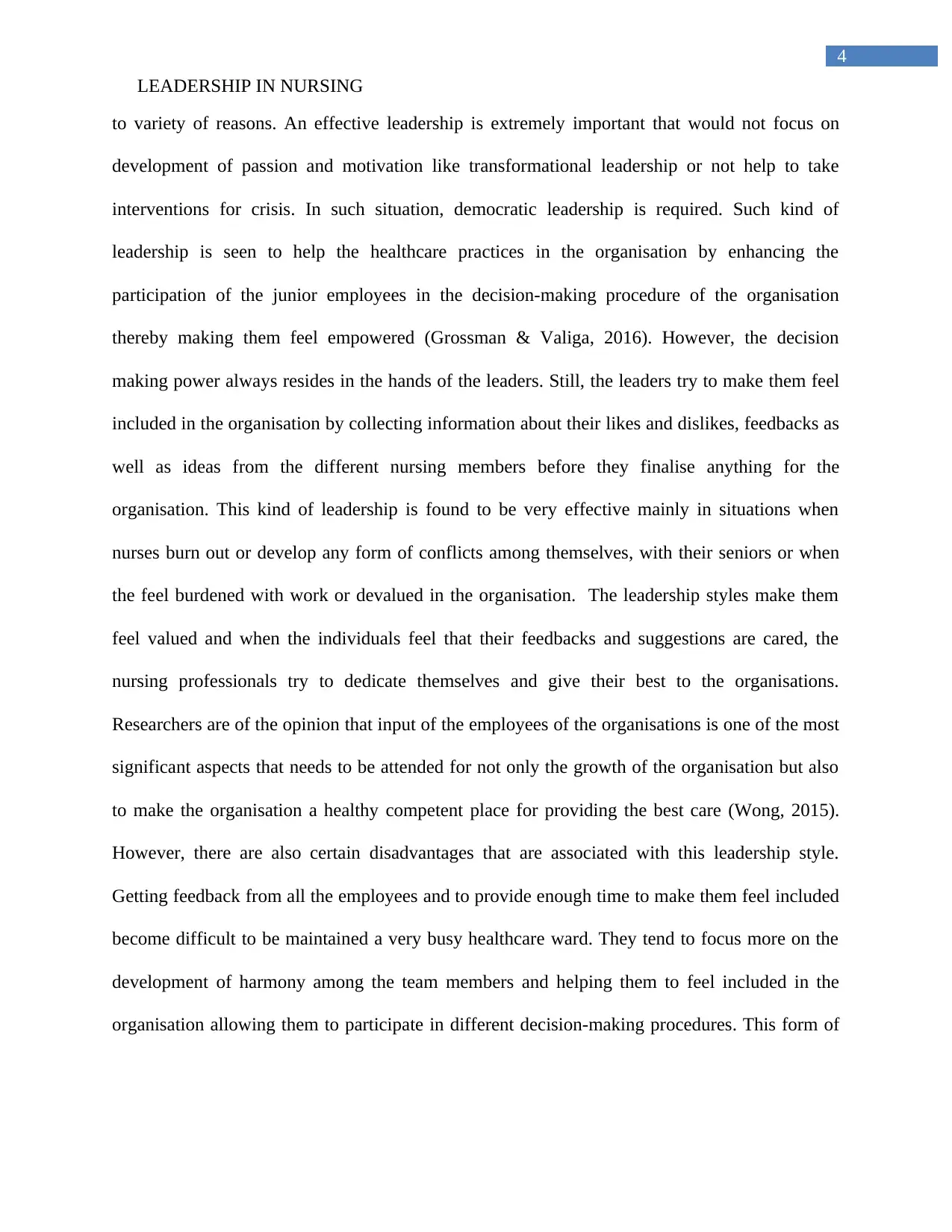
4
LEADERSHIP IN NURSING
to variety of reasons. An effective leadership is extremely important that would not focus on
development of passion and motivation like transformational leadership or not help to take
interventions for crisis. In such situation, democratic leadership is required. Such kind of
leadership is seen to help the healthcare practices in the organisation by enhancing the
participation of the junior employees in the decision-making procedure of the organisation
thereby making them feel empowered (Grossman & Valiga, 2016). However, the decision
making power always resides in the hands of the leaders. Still, the leaders try to make them feel
included in the organisation by collecting information about their likes and dislikes, feedbacks as
well as ideas from the different nursing members before they finalise anything for the
organisation. This kind of leadership is found to be very effective mainly in situations when
nurses burn out or develop any form of conflicts among themselves, with their seniors or when
the feel burdened with work or devalued in the organisation. The leadership styles make them
feel valued and when the individuals feel that their feedbacks and suggestions are cared, the
nursing professionals try to dedicate themselves and give their best to the organisations.
Researchers are of the opinion that input of the employees of the organisations is one of the most
significant aspects that needs to be attended for not only the growth of the organisation but also
to make the organisation a healthy competent place for providing the best care (Wong, 2015).
However, there are also certain disadvantages that are associated with this leadership style.
Getting feedback from all the employees and to provide enough time to make them feel included
become difficult to be maintained a very busy healthcare ward. They tend to focus more on the
development of harmony among the team members and helping them to feel included in the
organisation allowing them to participate in different decision-making procedures. This form of
LEADERSHIP IN NURSING
to variety of reasons. An effective leadership is extremely important that would not focus on
development of passion and motivation like transformational leadership or not help to take
interventions for crisis. In such situation, democratic leadership is required. Such kind of
leadership is seen to help the healthcare practices in the organisation by enhancing the
participation of the junior employees in the decision-making procedure of the organisation
thereby making them feel empowered (Grossman & Valiga, 2016). However, the decision
making power always resides in the hands of the leaders. Still, the leaders try to make them feel
included in the organisation by collecting information about their likes and dislikes, feedbacks as
well as ideas from the different nursing members before they finalise anything for the
organisation. This kind of leadership is found to be very effective mainly in situations when
nurses burn out or develop any form of conflicts among themselves, with their seniors or when
the feel burdened with work or devalued in the organisation. The leadership styles make them
feel valued and when the individuals feel that their feedbacks and suggestions are cared, the
nursing professionals try to dedicate themselves and give their best to the organisations.
Researchers are of the opinion that input of the employees of the organisations is one of the most
significant aspects that needs to be attended for not only the growth of the organisation but also
to make the organisation a healthy competent place for providing the best care (Wong, 2015).
However, there are also certain disadvantages that are associated with this leadership style.
Getting feedback from all the employees and to provide enough time to make them feel included
become difficult to be maintained a very busy healthcare ward. They tend to focus more on the
development of harmony among the team members and helping them to feel included in the
organisation allowing them to participate in different decision-making procedures. This form of
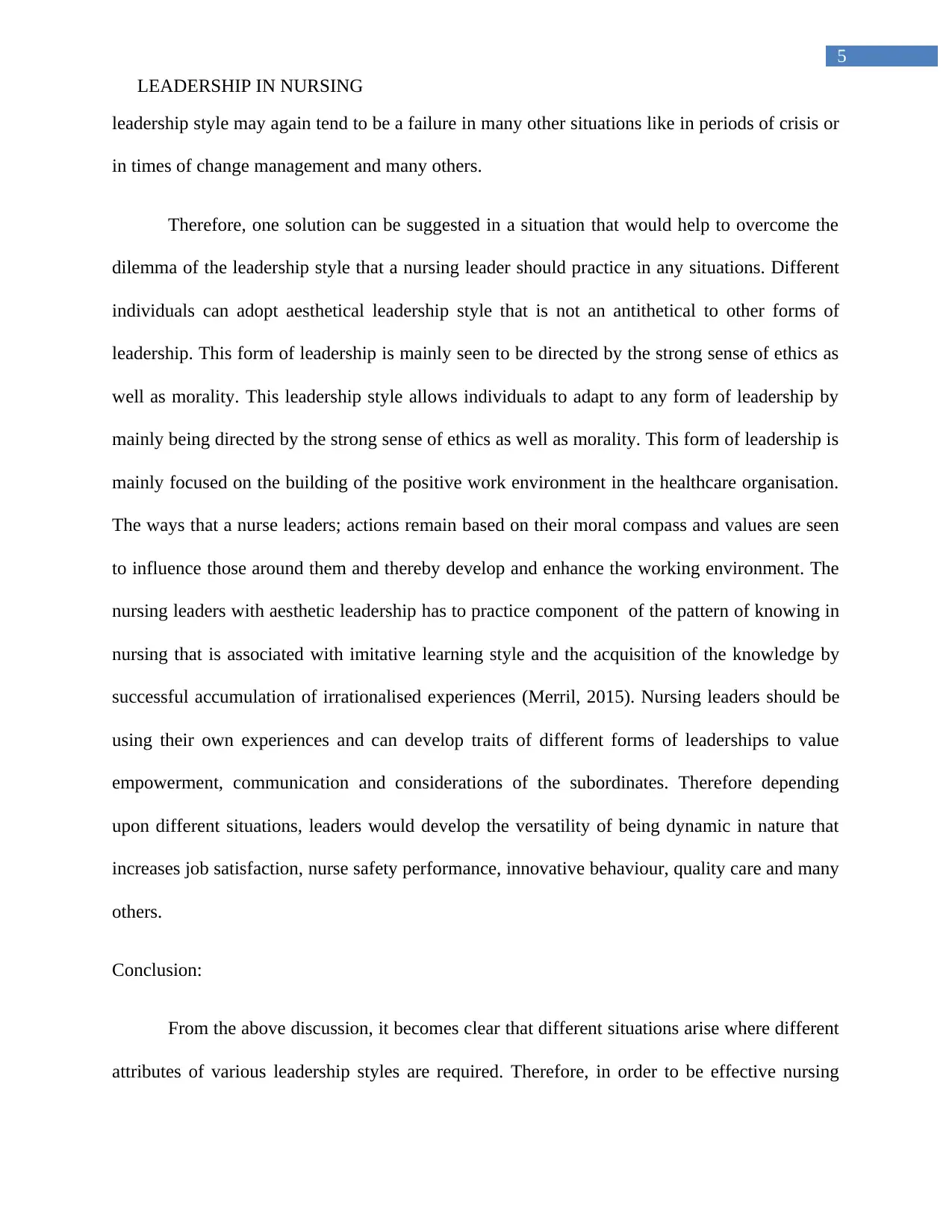
5
LEADERSHIP IN NURSING
leadership style may again tend to be a failure in many other situations like in periods of crisis or
in times of change management and many others.
Therefore, one solution can be suggested in a situation that would help to overcome the
dilemma of the leadership style that a nursing leader should practice in any situations. Different
individuals can adopt aesthetical leadership style that is not an antithetical to other forms of
leadership. This form of leadership is mainly seen to be directed by the strong sense of ethics as
well as morality. This leadership style allows individuals to adapt to any form of leadership by
mainly being directed by the strong sense of ethics as well as morality. This form of leadership is
mainly focused on the building of the positive work environment in the healthcare organisation.
The ways that a nurse leaders; actions remain based on their moral compass and values are seen
to influence those around them and thereby develop and enhance the working environment. The
nursing leaders with aesthetic leadership has to practice component of the pattern of knowing in
nursing that is associated with imitative learning style and the acquisition of the knowledge by
successful accumulation of irrationalised experiences (Merril, 2015). Nursing leaders should be
using their own experiences and can develop traits of different forms of leaderships to value
empowerment, communication and considerations of the subordinates. Therefore depending
upon different situations, leaders would develop the versatility of being dynamic in nature that
increases job satisfaction, nurse safety performance, innovative behaviour, quality care and many
others.
Conclusion:
From the above discussion, it becomes clear that different situations arise where different
attributes of various leadership styles are required. Therefore, in order to be effective nursing
LEADERSHIP IN NURSING
leadership style may again tend to be a failure in many other situations like in periods of crisis or
in times of change management and many others.
Therefore, one solution can be suggested in a situation that would help to overcome the
dilemma of the leadership style that a nursing leader should practice in any situations. Different
individuals can adopt aesthetical leadership style that is not an antithetical to other forms of
leadership. This form of leadership is mainly seen to be directed by the strong sense of ethics as
well as morality. This leadership style allows individuals to adapt to any form of leadership by
mainly being directed by the strong sense of ethics as well as morality. This form of leadership is
mainly focused on the building of the positive work environment in the healthcare organisation.
The ways that a nurse leaders; actions remain based on their moral compass and values are seen
to influence those around them and thereby develop and enhance the working environment. The
nursing leaders with aesthetic leadership has to practice component of the pattern of knowing in
nursing that is associated with imitative learning style and the acquisition of the knowledge by
successful accumulation of irrationalised experiences (Merril, 2015). Nursing leaders should be
using their own experiences and can develop traits of different forms of leaderships to value
empowerment, communication and considerations of the subordinates. Therefore depending
upon different situations, leaders would develop the versatility of being dynamic in nature that
increases job satisfaction, nurse safety performance, innovative behaviour, quality care and many
others.
Conclusion:
From the above discussion, it becomes clear that different situations arise where different
attributes of various leadership styles are required. Therefore, in order to be effective nursing
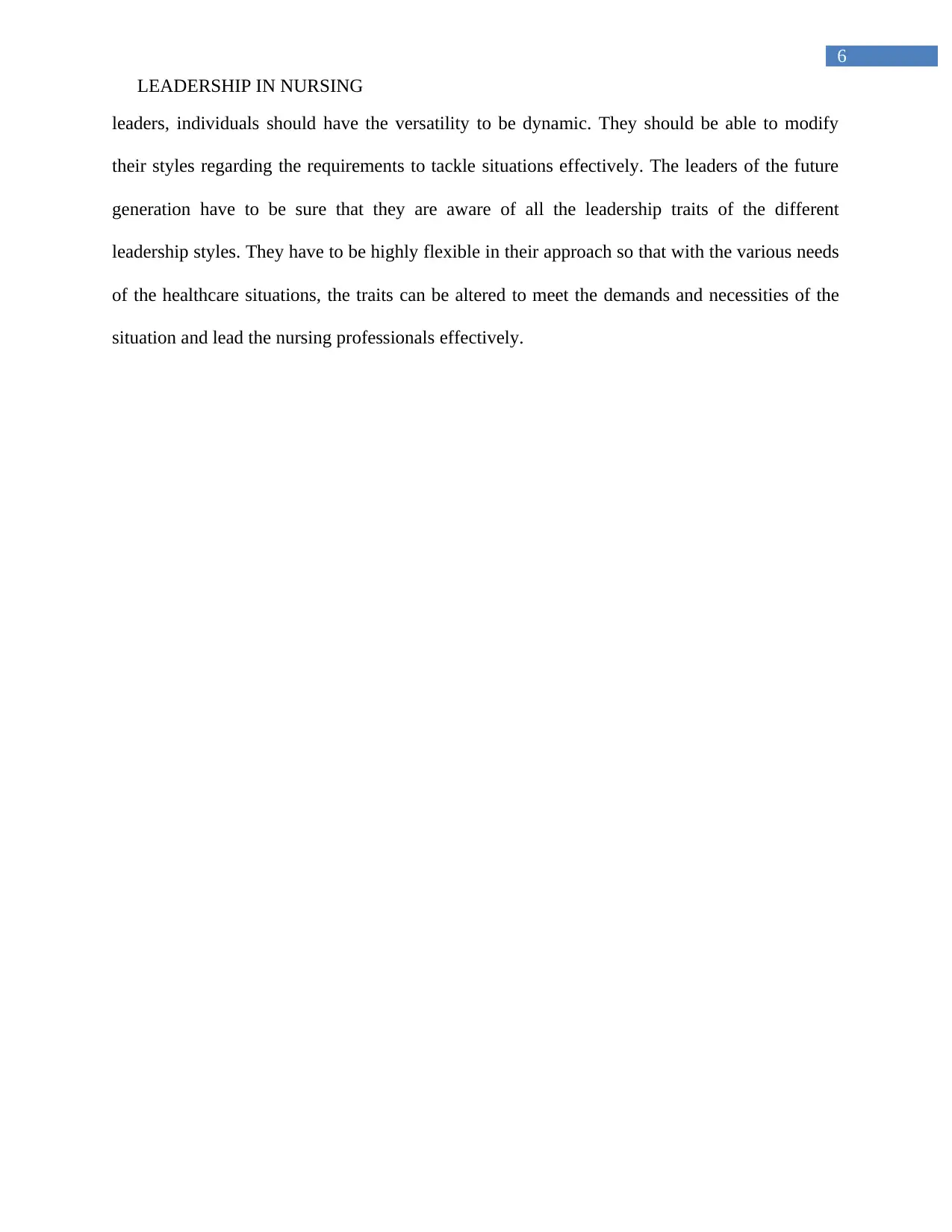
6
LEADERSHIP IN NURSING
leaders, individuals should have the versatility to be dynamic. They should be able to modify
their styles regarding the requirements to tackle situations effectively. The leaders of the future
generation have to be sure that they are aware of all the leadership traits of the different
leadership styles. They have to be highly flexible in their approach so that with the various needs
of the healthcare situations, the traits can be altered to meet the demands and necessities of the
situation and lead the nursing professionals effectively.
LEADERSHIP IN NURSING
leaders, individuals should have the versatility to be dynamic. They should be able to modify
their styles regarding the requirements to tackle situations effectively. The leaders of the future
generation have to be sure that they are aware of all the leadership traits of the different
leadership styles. They have to be highly flexible in their approach so that with the various needs
of the healthcare situations, the traits can be altered to meet the demands and necessities of the
situation and lead the nursing professionals effectively.
Paraphrase This Document
Need a fresh take? Get an instant paraphrase of this document with our AI Paraphraser
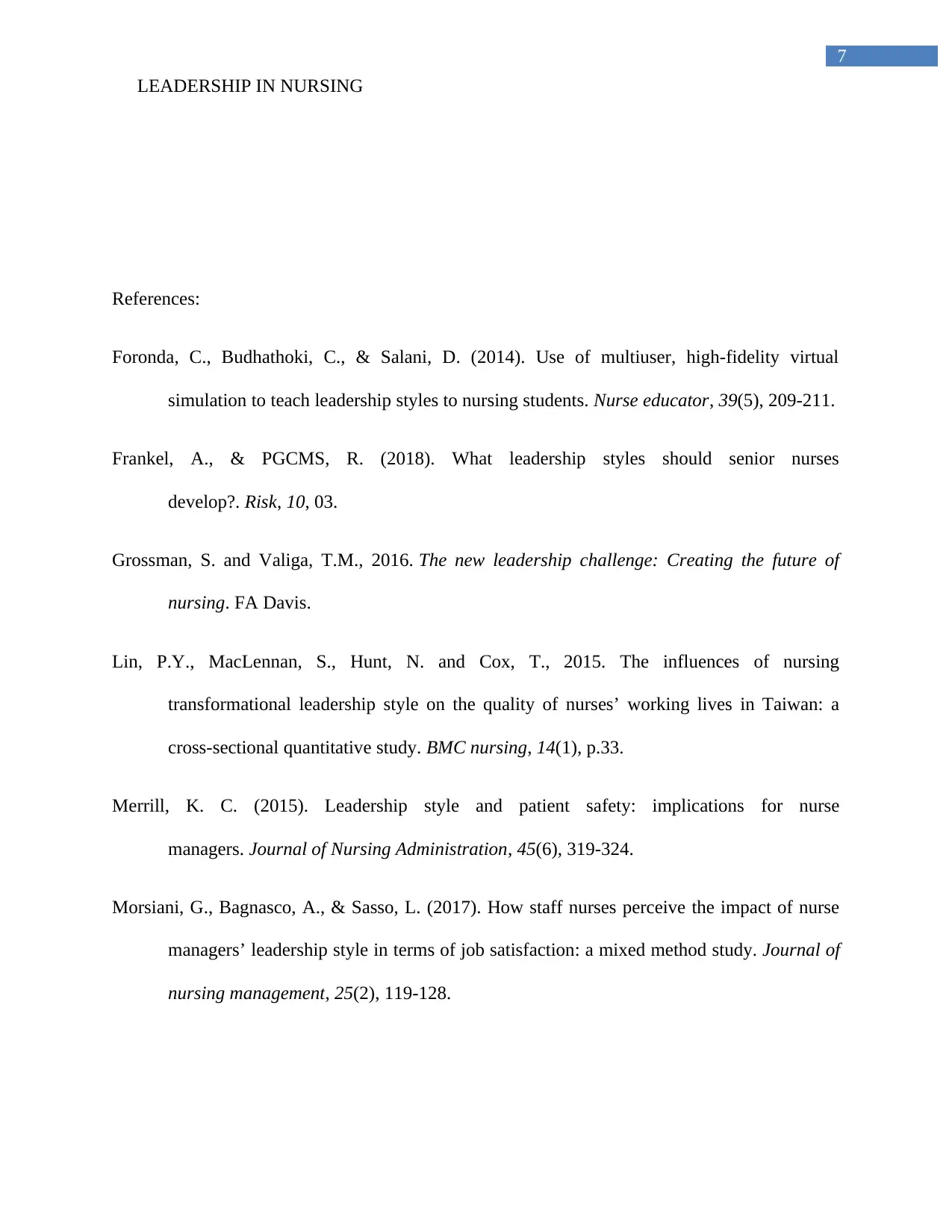
7
LEADERSHIP IN NURSING
References:
Foronda, C., Budhathoki, C., & Salani, D. (2014). Use of multiuser, high-fidelity virtual
simulation to teach leadership styles to nursing students. Nurse educator, 39(5), 209-211.
Frankel, A., & PGCMS, R. (2018). What leadership styles should senior nurses
develop?. Risk, 10, 03.
Grossman, S. and Valiga, T.M., 2016. The new leadership challenge: Creating the future of
nursing. FA Davis.
Lin, P.Y., MacLennan, S., Hunt, N. and Cox, T., 2015. The influences of nursing
transformational leadership style on the quality of nurses’ working lives in Taiwan: a
cross-sectional quantitative study. BMC nursing, 14(1), p.33.
Merrill, K. C. (2015). Leadership style and patient safety: implications for nurse
managers. Journal of Nursing Administration, 45(6), 319-324.
Morsiani, G., Bagnasco, A., & Sasso, L. (2017). How staff nurses perceive the impact of nurse
managers’ leadership style in terms of job satisfaction: a mixed method study. Journal of
nursing management, 25(2), 119-128.
LEADERSHIP IN NURSING
References:
Foronda, C., Budhathoki, C., & Salani, D. (2014). Use of multiuser, high-fidelity virtual
simulation to teach leadership styles to nursing students. Nurse educator, 39(5), 209-211.
Frankel, A., & PGCMS, R. (2018). What leadership styles should senior nurses
develop?. Risk, 10, 03.
Grossman, S. and Valiga, T.M., 2016. The new leadership challenge: Creating the future of
nursing. FA Davis.
Lin, P.Y., MacLennan, S., Hunt, N. and Cox, T., 2015. The influences of nursing
transformational leadership style on the quality of nurses’ working lives in Taiwan: a
cross-sectional quantitative study. BMC nursing, 14(1), p.33.
Merrill, K. C. (2015). Leadership style and patient safety: implications for nurse
managers. Journal of Nursing Administration, 45(6), 319-324.
Morsiani, G., Bagnasco, A., & Sasso, L. (2017). How staff nurses perceive the impact of nurse
managers’ leadership style in terms of job satisfaction: a mixed method study. Journal of
nursing management, 25(2), 119-128.
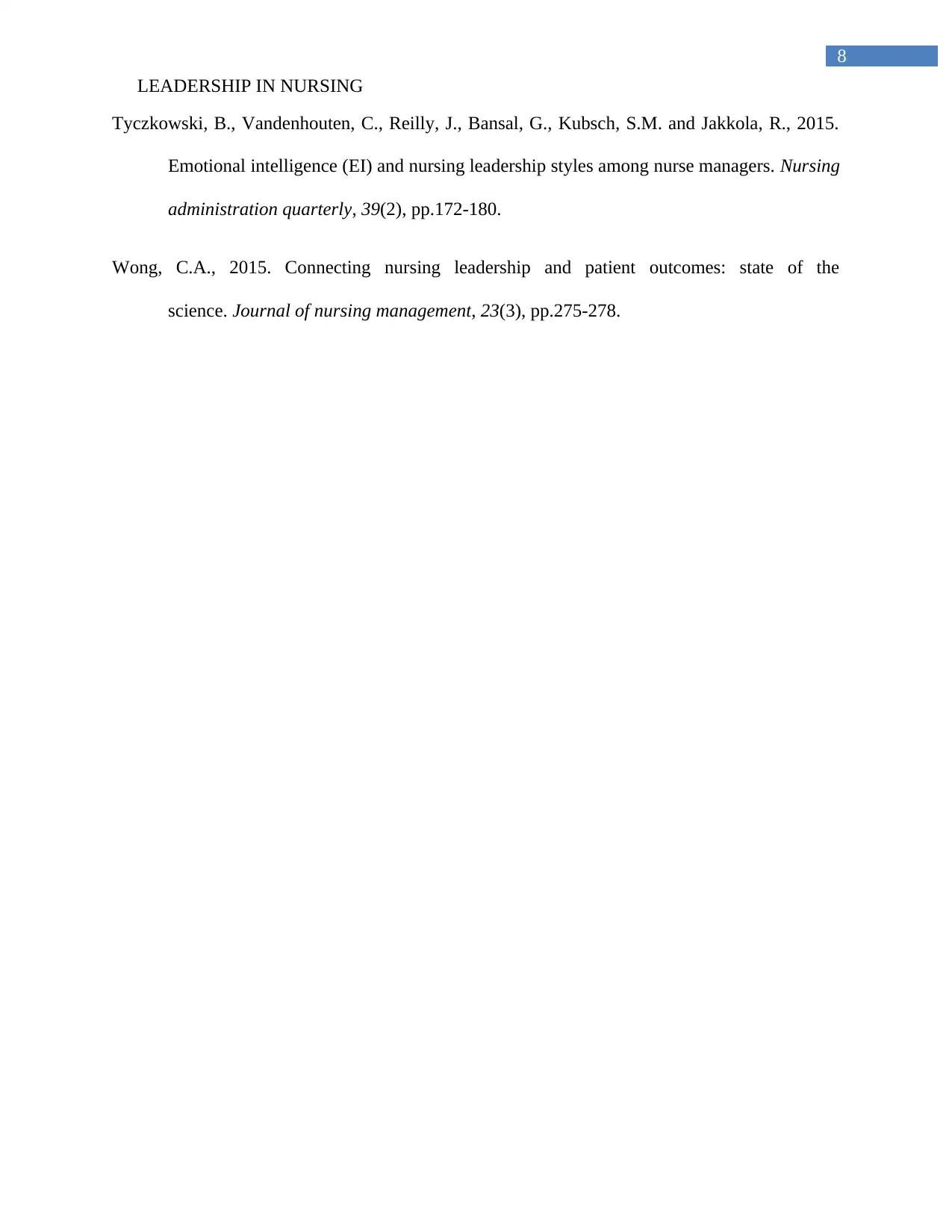
8
LEADERSHIP IN NURSING
Tyczkowski, B., Vandenhouten, C., Reilly, J., Bansal, G., Kubsch, S.M. and Jakkola, R., 2015.
Emotional intelligence (EI) and nursing leadership styles among nurse managers. Nursing
administration quarterly, 39(2), pp.172-180.
Wong, C.A., 2015. Connecting nursing leadership and patient outcomes: state of the
science. Journal of nursing management, 23(3), pp.275-278.
LEADERSHIP IN NURSING
Tyczkowski, B., Vandenhouten, C., Reilly, J., Bansal, G., Kubsch, S.M. and Jakkola, R., 2015.
Emotional intelligence (EI) and nursing leadership styles among nurse managers. Nursing
administration quarterly, 39(2), pp.172-180.
Wong, C.A., 2015. Connecting nursing leadership and patient outcomes: state of the
science. Journal of nursing management, 23(3), pp.275-278.
1 out of 9
Related Documents
Your All-in-One AI-Powered Toolkit for Academic Success.
+13062052269
info@desklib.com
Available 24*7 on WhatsApp / Email
![[object Object]](/_next/static/media/star-bottom.7253800d.svg)
Unlock your academic potential
© 2024 | Zucol Services PVT LTD | All rights reserved.





